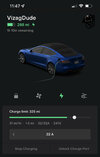I got my NEMA 14-50 receptacle/outlet installed for my MYLR expected in a few months. My issue is that due to how my house/garage is configured, it’s about 8-10 feet from where the car’s charge port will be when parked. I have a Tesla cable organizer kit and I would like to loop the cable on the wall back by the back of the car.
Does anyone have any thoughts for supporting/securing the cable between the outlet and where I want the looped cable hanger placed?
Oh yeah…thanks to how the sheet rock and cinder block is built, I’ve had the outlet installed “upside down” and will be hanging the charging unit above the outlet instead of below. (Like the second installation picture in the Tesla Shop product description.)
Does anyone have any thoughts for supporting/securing the cable between the outlet and where I want the looped cable hanger placed?
Oh yeah…thanks to how the sheet rock and cinder block is built, I’ve had the outlet installed “upside down” and will be hanging the charging unit above the outlet instead of below. (Like the second installation picture in the Tesla Shop product description.)



